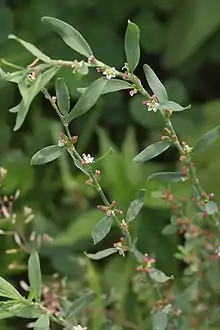Polygonum aviculare
Polygonum aviculare or common knotgrass is a plant related to buckwheat and dock. It is also called prostrate knotweed, birdweed, pigweed and lowgrass. It is an annual found in fields and wasteland, with white flowers from June to October. It is widespread across many countries in temperate regions, apparently native to Eurasia, naturalized in temperate parts of the Southern Hemisphere.[2][3][4][5][6][7]
| Common knotgrass | |
|---|---|
 | |
| Scientific classification | |
| Kingdom: | Plantae |
| Clade: | Tracheophytes |
| Clade: | Angiosperms |
| Clade: | Eudicots |
| Order: | Caryophyllales |
| Family: | Polygonaceae |
| Genus: | Polygonum |
| Species: | P. aviculare |
| Binomial name | |
| Polygonum aviculare L. 1753 | |
| Synonyms[1] | |
|
Synonymy
| |
Description
Common knotgrass is an annual herb with a semi-erect stem that may grow from 10 to 40 cm (4 to 16 in) high. The leaves are hairless and short-stalked. They are longish-elliptical with short stalks and rounded bases; the upper ones are few and are linear and stalkless. The stipules are fused into a stem-enclosing, translucent sheath known as an ochrea that is membranous and silvery. The flowers are regular, green with white or pink margins. Each has five perianth segments, overlapping at the base, five to eight stamens and three fused carpels. The fruit is a dark brown, three-edged nut. The seeds need light to germinate which is why this plant appears in disturbed soil in locations where its seeds may have lain dormant for years. It is a common carrier of the parasitic pathogen powdery mildew,[8] which can give the leaves a whitish appearance.[3][9]
Subspecies
Polygonum aviculare has a wide distribution as an arable weed and plant of fields, shingle, sand, roadsides, yards and waste places. There is much morphological variation among different populations and several different sub-species are recognized:[1][2][3][9]
- Polygonum aviculare subsp. aviculare – very widespread
- Polygonum aviculare subsp. boreale (Lange) Karlsson – Greenland, Labrador, Newfoundland, Scandinavia
- Polygonum aviculare subsp. buxiforme (Small) Costea & Tardif – North America
- Polygonum aviculare subsp. depressum (Meisn.) Arcang. – Europe, North America
- Polygonum aviculare var. fusco-ochreatum (Kom.) A.J.Li – northeastern China, Russian Far East
- Polygonum aviculare subsp. neglectum (Besser) Arcangeli – Europe, North America
- Polygonum aviculare subsp. rurivagum (Jord. ex Boreau) Berher – Europe, North America
Distribution
Widespread and common in Great Britain,[10] Ireland,[10][11] and Scandinavia.[12]
Habitat
It is common on roadsides and arable ground in the British Isles.[11]
Chemistry
Polygonum aviculare contains the flavonols avicularin, myricitrin and juglanin.[13] The flavanoids astragalin and betmidin, and the lignan aviculin have also been found.[14] The diterpene alkaloid panicudine is another known component.[15]
Fossil record
One fossil fruit of Polygonum aviculare has been extracted from borehole samples of the Middle Miocene fresh water deposits in Nowy Sacz Basin, West Carpathians, Poland.[16]
Cuisine
It formed a traditional ingredient in porridge consumed by Germanic peoples of western Europe, and has been found in numerous autopsies of peat bodies, including the Tollund Man.
In Vietnam, where it is called rau đắng, it is widely used to prepare soup and hot pot, particularly in the southern region.
References
- The Plant List, Polygonum aviculare L.
- Flora of China, Polygonum aviculare Linnaeus, 1753. 萹蓄 bian xu
- Flora of North America, Polygonum aviculare Linnaeus, 1753. Doorweed, knotgrass, renouée des oiseaux
- Atlas of Living Australia, Polygonum aviculare L., Wireweed
- Altervista Flora Italiana, Polygonum aviculare L. includes photos and European distribution map
- Lindau, G. 1894. Beiträge zur argentinischen Flora. Botanische Jahrbücher für Systematik, Pflanzengeschichte und Pflanzengeographie 19(4, Beibl. 48): 8–23 descriptions and geographic information in Latin, commentary in German
- Gibbs Russell, G. E., W. G. M. Welman, E. Retief, K. L. Immelman, G. Germishuizen, B. J. Pienaar, M. Van Wyk & A. Nicholas. 1987. List of species of southern African plants. Memoirs of the Botanical Survey of South Africa 2(1–2): 1–152(pt. 1), 1–270(pt. 2).
- https://www.researchgate.net/publication/338187775 Parasitic activity of powdery mildew (pathogen strain hmlac226) on prostrate knotweed (polygonum aviculare l.) at various locations of Shenyang, northeast China , Iqbal, M. F., Fend, Y. L., Liu, M. C., Lu, X. R., Nasir, M., Sikandar, A., 2019
- "Knotgrass: Polygonum aviculare". NatureGate. Retrieved 2013-12-30.
- Clapham, A.R. , Tutin, T.G. and Warburg, E.F. 1968. Excursion Flora of the British Isles. Cambridge Press. ISBN 0-521-04656-4
- Parnell, J. and Curtis, T. 2012. Webb's An Irish Flora. Cork University Press. ISBN 978-185918-4783
- "Knotgrass". Planteværn Online. Aarhus University. Retrieved 1 February 2016.
- Xu, Fuquan; Guan, Huashi; Li, Guoqiang; Liu, Hongbing (2009). "LC Method for Analysis of Three Flavonols in Rat Plasma and Urine after Oral Administration of Polygonum aviculare Extract". Chromatographia. 69 (11–12): 1251–1258. doi:10.1365/s10337-009-1088-x. S2CID 93888073.
- Kim, Hyoung Ja; Woo, Eun-Rhan; Park, Hokoon (1994). "A Novel Lignan and Flavonoids from Polygonum aviculare". Journal of Natural Products. 57 (5): 581–586. doi:10.1021/np50107a003.
- Salama, Hediat M.H.; Marraiki, Najat (January 2010). "Antimicrobial activity and phytochemical analyses of Polygonum aviculare L. (Polygonaceae), naturally growing in Egypt". Saudi Journal of Biological Sciences. 17 (1): 57–63. doi:10.1016/j.sjbs.2009.12.009. PMC 3730555. PMID 23961059.
- Łańcucka-Środoniowa M.: Macroscopic plant remains from the freshwater Miocene of the Nowy Sącz Basin (West Carpathians, Poland) [Szczątki makroskopowe roślin z miocenu słodkowodnego Kotliny Sądeckiej (Karpaty Zachodnie, Polska)]. Acta Palaeobotanica 1979 20 (1): 3-117.
External links
- photo of herbarium specimen collected in Nuevo León in Mexico in 1989
- Howard, Michael. Traditional Folk Remedies, (Century, 1987); page 162.